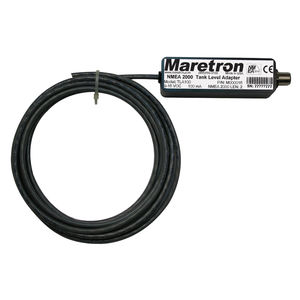
- Company
- Products
- Catalogs
- News & Trends
- Exhibitions
Level sensor TLM100for boatfor tanksultrasonic
Add to favorites
Compare this product
Characteristics
- Measured value
- level
- Application domain
- for boat
- Applications
- for tanks
- Other characteristics
- ultrasonic
Description
Maretron's TLM100 is used to sense fluid levels of tanks by using ultrasonic technology. Ultrasonic, or sound waves, are transmitted via the TLM100 mounted at the top of the tank and the flight times of the sound waves to and from the fluid are measured much like a depth sensor. What this means for you is that there are no difficult to handle long probes protruding into the tank, which often foul and/or corrode. Once the TLM100 calculates and transmits the fluid level over the NMEA 2000® network, you can observe tank levels anywhere on the vessel where there is an NMEA 2000® compatible display such as Maretron's N2KView® vessel monitoring system, or by Maretron's DSM250 / DSM410 color graphics displays.
The TLM100 is capable of sensing fluid levels in tanks up to 40" (1.02m) in depth. It can be used for diesel, fresh water, waste water, black water, and oil tanks (see TLM150 for gasoline tanks or FPM100 for deeper tanks). Unlike most tank senders that only work with rectangular tanks, the TLM100 can be calibrated for irregular tank shapes so you can know the true fluid level in your tanks.
The TLM100 is mounted directly to the top of tanks using the industry standard SAE J1810 5-hole mounting pattern. The TLM100 can also be mounted to tanks with threaded tank openings using optional adapters that included both a 1.5" NPT and a 1.25" BSP adapter. There are other important TLM100 optional accessories including an optional focus tube to permit use on boats with planing hulls, which is required if the vessel spends a significant amount of time with the bow pitched up.
Catalogs
Exhibitions
Meet this supplier at the following exhibition(s):


Related Searches
- Boat antenna
- Boat sensor
- Temperature sensor
- Boat screen
- Depth transducer
- Multi-function screen
- Ultrasonic sensor
- Display
- Boat display
- Ship software
- Digitall display
- Multi-function display
- Through-hull transducer
- GPS antenna
- Boat software
- NMEA 2000® sensor
- Maretron network interface
- Navigation software
- Meteorological station
- Boat network interface
*Prices are pre-tax. They exclude delivery charges and customs duties and do not include additional charges for installation or activation options. Prices are indicative only and may vary by country, with changes to the cost of raw materials and exchange rates.







